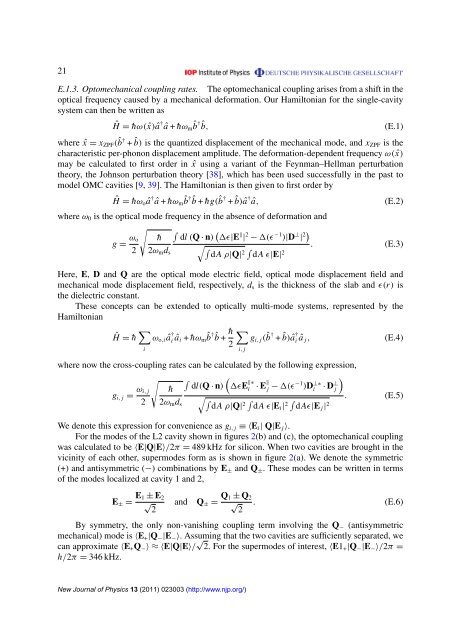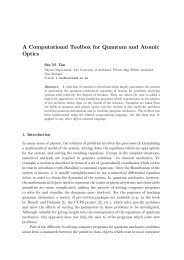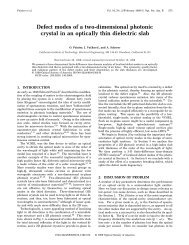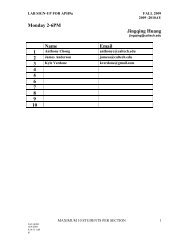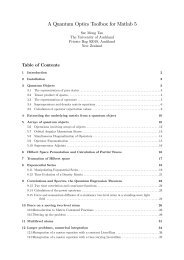Slowing and stopping light using an optomechanical crystal array
Slowing and stopping light using an optomechanical crystal array
Slowing and stopping light using an optomechanical crystal array
Create successful ePaper yourself
Turn your PDF publications into a flip-book with our unique Google optimized e-Paper software.
21<br />
E.1.3. Optomech<strong>an</strong>ical coupling rates. The optomech<strong>an</strong>ical coupling arises from a shift in the<br />
optical frequency caused by a mech<strong>an</strong>ical deformation. Our Hamiltoni<strong>an</strong> for the single-cavity<br />
system c<strong>an</strong> then be written as<br />
Ĥ = ¯hω( ˆx)â † â + ¯hω m ˆb † ˆb,<br />
(E.1)<br />
where ˆx = x ZPF (ˆb † + ˆb) is the qu<strong>an</strong>tized displacement of the mech<strong>an</strong>ical mode, <strong><strong>an</strong>d</strong> x ZPF is the<br />
characteristic per-phonon displacement amplitude. The deformation-dependent frequency ω( ˆx)<br />
may be calculated to first order in ˆx <strong>using</strong> a vari<strong>an</strong>t of the Feynm<strong>an</strong>–Hellm<strong>an</strong> perturbation<br />
theory, the Johnson perturbation theory [38], which has been used successfully in the past to<br />
model OMC cavities [9, 39]. The Hamiltoni<strong>an</strong> is then given to first order by<br />
Ĥ = ¯hω o â † â + ¯hω m ˆb † ˆb + ¯hg(ˆb † + ˆb)â † â,<br />
where ω 0 is the optical mode frequency in the absence of deformation <strong><strong>an</strong>d</strong><br />
√<br />
g = ω o<br />
2<br />
(E.2)<br />
∫ (<br />
¯h dl (Q · n) ɛ|E ‖ | 2 − (ɛ −1 )|D ⊥ | 2)<br />
√<br />
2ω m d ∫ ∫ . (E.3)<br />
s<br />
dA ρ|Q|<br />
2<br />
dA ɛ|E| 2<br />
Here, E, D <strong><strong>an</strong>d</strong> Q are the optical mode electric field, optical mode displacement field <strong><strong>an</strong>d</strong><br />
mech<strong>an</strong>ical mode displacement field, respectively, d s is the thickness of the slab <strong><strong>an</strong>d</strong> ɛ(r) is<br />
the dielectric const<strong>an</strong>t.<br />
These concepts c<strong>an</strong> be extended to optically multi-mode systems, represented by the<br />
Hamiltoni<strong>an</strong><br />
Ĥ = ¯h ∑ i<br />
ω o,i â † i â i + ¯hω m ˆb † ˆb + ¯h<br />
2<br />
∑<br />
g i, j (ˆb † + ˆb)â † i â j ,<br />
i, j<br />
(E.4)<br />
where now the cross-coupling rates c<strong>an</strong> be calculated by the following expression,<br />
√ ∫ (<br />
)<br />
g i, j = ω i, j ¯h dl(Q · n) ɛE ‖∗<br />
i · E ‖ j − (ɛ−1 )Di<br />
⊥∗ · D ⊥ j<br />
√<br />
2 2ω m d ∫ ∫ s dA ρ|Q|<br />
2<br />
dA ɛ|E i | ∫ . (E.5)<br />
2 dAɛ|E j | 2<br />
We denote this expression for convenience as g i, j ≡ 〈E i | Q|E j 〉.<br />
For the modes of the L2 cavity shown in figures 2(b) <strong><strong>an</strong>d</strong> (c), the optomech<strong>an</strong>ical coupling<br />
was calculated to be 〈E|Q|E〉/2π = 489 kHz for silicon. When two cavities are brought in the<br />
vicinity of each other, supermodes form as is shown in figure 2(a). We denote the symmetric<br />
(+) <strong><strong>an</strong>d</strong> <strong>an</strong>tisymmetric (−) combinations by E ± <strong><strong>an</strong>d</strong> Q ± . These modes c<strong>an</strong> be written in terms<br />
of the modes localized at cavity 1 <strong><strong>an</strong>d</strong> 2,<br />
E ± = E 1 ± E 2<br />
√<br />
2<br />
<strong><strong>an</strong>d</strong> Q ± = Q 1 ± Q 2<br />
√<br />
2<br />
. (E.6)<br />
By symmetry, the only non-v<strong>an</strong>ishing coupling term involving the Q − (<strong>an</strong>tisymmetric<br />
mech<strong>an</strong>ical) mode is 〈E + |Q − |E − 〉. Assuming that the two cavities are sufficiently separated, we<br />
c<strong>an</strong> approximate 〈E + Q − 〉 ≈ 〈E|Q|E〉/ √ 2. For the supermodes of interest, 〈E1 + |Q − |E − 〉/2π =<br />
h/2π = 346 kHz.<br />
New Journal of Physics 13 (2011) 023003 (http://www.njp.org/)


